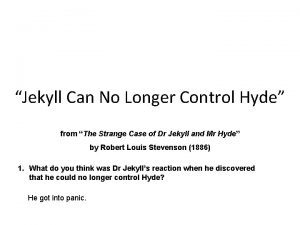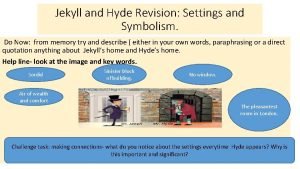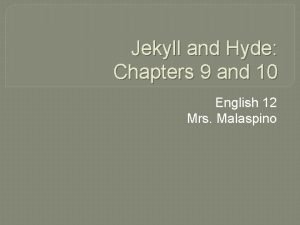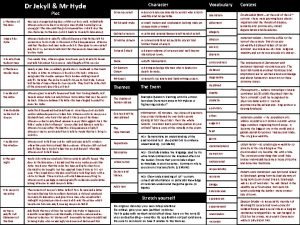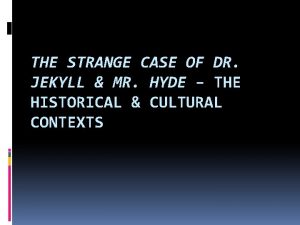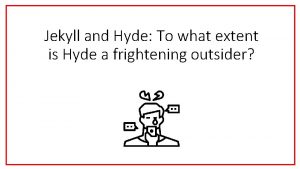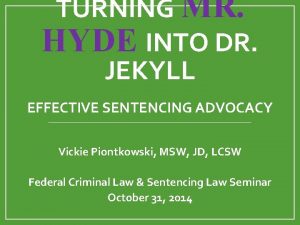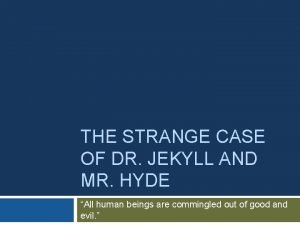Jekyll Turns Into Hyde from The Strange Case





- Slides: 5

“Jekyll Turns Into Hyde” from “The Strange Case of Dr Jekyll and Mr Hyde” by Robert Louis Stevenson (1886)

GUIDED ANALYSIS 1. Read paragraph 1 Why does Jekyll hesitate before putting his experiment into practice? Because he is conscious that the experiment could be lethal. 2. Read paragraph 2 It is about Dr Jekyll’s physical transformation. Highlight the words / phrases which describe: Pain and suffering “The most racking (= devastating) pangs (= spasms)” (l. 13); “a grinding in the bones” (l. 13); “deadly nausea” (l. 13); “a horror of the spirit” (l. 14); “agonies” (l. 15); Joy and lightness “something strange” (16); “indescribably new …. incredibly sweet” (l. 17); “younger” (l. 17); “lighter” (l. 18); “happier in body” (l. 18); “heady recklessness” (l. 18); “a solution of the bonds of obligation” (ll. 19 -20); “freedom of the soul” (ll. 20 -21); “delighted me like wine” (l. 23).

GUIDED ANALYSIS 3. Read paragraph 3 and 4 a. How does Mr Hyde differs from Dr Jekyll? b. How does Mr Hyde differs from all other men? a. Edward Hyde is “smaller, slighter and younger” (l. 31) than Henry Jekyll because, while the good side of Dr Jekyll has been exercised through ”a life of effort, virtue and control” (ll. 29), his evil side has not, that’s why Mr Hyde is “less robust and less developed” than the good Mr Jekyll” (l. 27). Moreover, while good shines on the face of Dr Jekyll, all the signs of evil show on Hyde’s face and his body is marked by “deformity and decay” (l. 34). b. Mr Hyde is pure evil and not, as everyone else, a compound of good and evil. c. What conflict does Dr Jekyll go through? c. He cannot decide whether to keep the dualism good/evil present in every human being or let evil prevail. In fact, Jekyll feels almost attracted by Hyde’s ugly image, which to him seems livelier than his divided self, but he is afraid of losing his own identity. After a moment of hesitation, Dr Jekyll decides to face the second part of his experiment and try and revert to his previous self.

GUIDED ANALYSIS 4. Focus on the structure. give a heading to each paragraph. • Paragraph 1: Doubts and Fears. • Paragraph 2: The experiment takes place. • Paragraph 3: The two sides of the same self. • Paragraph 4: back again – from Hyde to Jekyll. 5. Focus on the language. What features of the Gothic tradition are still present in the passage to create an atmosphere of mystery, suspense, fear and horror? What elements can be considered the forerunners of science fiction? Highlight words and phrases for both: Gothic tradition the night setting, the smoking chemicals, and the solitude of the scientist before his experiment are all features typical of tales of horror and mystery: “I risked death” (l. 2); “alarm” (l. 6); “late one accursed night” (l. 9); “a horror of the spirit” (l. 14); ”the hour of birth or death” (l. 14); “agonies” (l. 15); “the pangs of dissolution” (l. 48).

What elements can be considered the forerunners of science fiction? Highlight words and phrases referring to it: science fiction The experiment in itself; Jekyll’s attempt to overcome the laws of nature: “I put this theory to the test of practice” (l. 1); “the temptation of discovery” (l. 5); “I knew, from my experiments” (ll. 8 -9); “a strong blow of courage” (l. 11); “I have observed” (l. 39); “the second and conclusive experiment had yet to be attempted” (ll. 44 -45). 6. “The Strange Case of Dr Jekyll and Mr Hyde” contains Gothic, science fiction and psychological elements. Discuss this statement comparing Stevenson’s novel and Mary Shelley’s “Frankenstein”. The influence of scientific experiments is clearly visible in the creation, after drinking the drug, of two different beings, Jekyll and Hyde, in Stevenson’s novel, and in the creation of the monster by assembling parts taken from dead men’s bodies in Mary Shelley’s “Frankenstein”. In both the novels there is an attempt to overcome the laws of nature: Jekyll believes he might separate good from evil; Frankenstein tries to acquire God-like power by creating a human being. The theme of the double with the struggle between good and evil and its psychological implications is also present in the monster of Mary Shelley’s novel. In both works of fiction Gothic elements can be found in the settings and in the mystery that accompanies the development of the stories.
